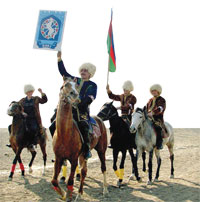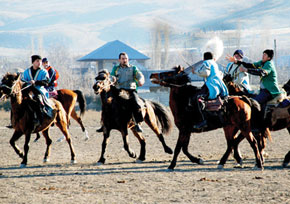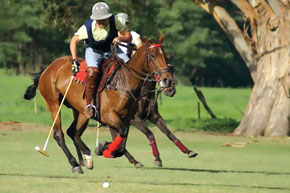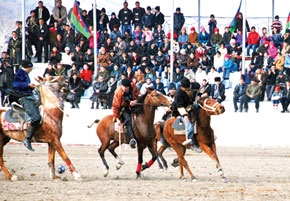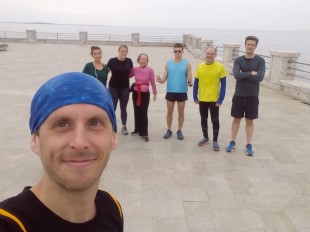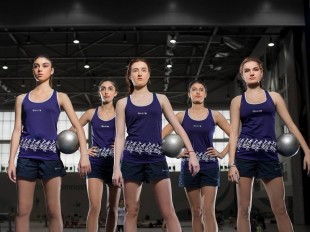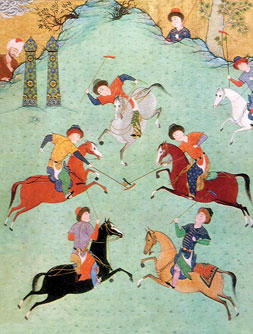 Pages 18-22
Pages 18-22by Rafael Emin
The game chovgan is a sport played on horseback with a history going back 2,400 years. It was one of the most popular sports across the Middle East, including Azerbaijan. In the Middle Ages, it was central to the training programmes of special-purpose cavalry units. Turks organized horse racing during holiday festivities, and chovgan and other horseback sports were also played. The chovgan contests mentioned in the epic poem Kitabi Dede Gorgud were a favourite game with the Oghuz tribes. In the episode called “The ransacking of Salur Qazan’s house”, the word chovgan means a piece of wood with a curved end used to catch sheep. Incidentally, the Persian word jovkan, borrowed from Turkic, has the same meaning. Horse sports like “Qapaq”, “Piyala va ox”, “Baharband”, “Yayliq”, “Gardak qacirma” and “Sur papaq” were also popular with the Oghuz Turks.
An portrayal of a game of chovgan was discovered on earthenware pots dated to the 9th century, which were found during archaeological excavations of an ancient populated area of Azerbaij an called Oranqala. The “Qabus nameh”, an 11th century book of manners and ethics, describes how jovkan was conducted in Iran.
In the Middle Ages there was great interest in these competitions and it featured in the works of prominent thinkers of the period. The great Azerbaij ani poet of the 12th century, Nizami Gancavi, wrote about the game in his poem “Xosrov va Sirin”. It transpires from the poem that women in Azerbaij an were men’s equals in playing chovgan. Nizami’s near contemporary, the poet Xaqani Sirvani, also wrote about the game. Painters of the Tabriz miniature school, which dates back to the 15-16th centuries, often depicted chovgan in their works.
Chovgan in the Middle Ages
From sources: “… as soon as the referee who controlled the game raised the red shawl in his hand, the bugle was sounded. Then the players, four per team, went round the field. On each side of the field there was a stone tower goal, the height of a man. A red fl ag was installed on one of the towers and a blue fl ag on the other.” “Musical instruments like the gara zurna, drum, and four-gulaj-long qaraney were played at these kinds of entertaining sport games.” [translator’s note: “gulaj” is a unit of measurement “equal to the length from the tip of the finger of one hand to the tip of the finger of the other hand” –‘Polyglot’ Azeri-English dictionary].
“The participants in the contest had to pass the ball between the towers using a ‘chovgan’ made of wood.”
“The participants in the contest had to pass the ball between the towers using a ‘chovgan’ made of wood.”
How the ball and chovgan were made
The ball used in chovgan was made from combed wool. The ball was made by hand from 150-160 grams of wool and was as hard as it was possible to make. After shaping the ball, it was kept in hot water for up to 30 minutes. During this time the ball kept its shape but compressed further. After being removed from the water, it was again rubbed very hard.
It was then given a covering of special leather. Balls made by this method acquired the form of an elastic sphere. The piece of wood used to hit the ball was called a chovgan; it was made from a piece of wood with one end bent in a special manner. Its length depended on the height of the horses used and the height of the players. The upper edge of the bent part of the chovgan was open. This was used to lift the ball off the ground. The horses’ saddles were fastened by two or three girths so that they did not slip off after sharp movements.
It was then given a covering of special leather. Balls made by this method acquired the form of an elastic sphere. The piece of wood used to hit the ball was called a chovgan; it was made from a piece of wood with one end bent in a special manner. Its length depended on the height of the horses used and the height of the players. The upper edge of the bent part of the chovgan was open. This was used to lift the ball off the ground. The horses’ saddles were fastened by two or three girths so that they did not slip off after sharp movements.
The rules of the game (19th century)
A chovgan field was 150 metres long and 120 metres wide, although it could be as small as 90 by 60 metres. The goal posts, which were made from wooden pillars and installed at each end of the field, had to be 2.5 metres high. According to information from sources, a game lasted two hours, including a break, and was accompanied by music. Before the game started, bugles were sounded and then the commander of a specially trained regiment put the ball onto the field and so the contest started. The horses used in the game were specially trained. Three referees controlled the game, the chief one being a cavalryman. All players dressed in traditional clothing – papakh (round fur hat), arkhalig ( ), wide trousers and light shoes.
How chovgan got the name polo
The game chovgan, widespread in Azerbaijan and other oriental countries, has been known to the Western world since 1860. In that year, the British occupiers of India became acquainted with a game which was called pulu (meaning a ball) in the local dialect in Kashmir. The game, which the English called polo, was passed on to other European countries and also to America. Following a British initiative, polo was included in the programme of the second Olympic Games held in Paris in 1900. Five teams from three countries participated. Contests are held nowadays in European and American countries in variations of the popular chovgan: “like polo”, “BMX polo”, “yak polo”, “water polo”, “camel polo”, “cycle polo”, “canoe polo”, “elephant polo”, “golfcart polo”, “segway polo” and “spongee polo”.
The polo field and the rules of the game
The field is outdoors: 275 metres long and 146 metres wide. Over the boundary lines of the fi eld and behind the goals there is enough room for a horse to turn. The distance between the posts installed as goals is 7.3 metres.
The players hit the ball with a 120-centimetre- long wooden mallet, which has a cylindrical piece of wood joined to its tip. The polo club also resembles a mallet with a long handle. There is a strap on the handle of the club which is fastened round the wrist. By the rules of modern polo games, the wooden mallet must be held only in the right hand. In European and American countries, they prefer to make the mallet from bamboo. The ball is made from willow root and bamboo; it is 8 centimetres in diameter and weighs 113-115 grams. A polo match is played between two opposing teams and consists of four, six or eight chukkas (rounds) lasting between seven and seven and a half minutes each. Each team has four members; eight riders compete on the field. Each player has his own responsibilities. Player 1 is the off ensive player (forward). Player 2 builds the game, and players 3 and 4 organize the defence. Their role is to impede off ensives by the opposing team and to pass the ball to their team mates. Each player is given a rating for the skills demonstrated during the contest, which is between 2 and +1.
Three referees control the game. Two referees control the game while riding horses in the field; the other is the main referee and controls the game from the side.
The team that scores the most goals wins the game. The horses are changed between rounds in the game. There is also a small break halfway through the game, between rounds. Polo horses, which are specially trained, are not used in more than two rounds and are replaced immediately. A polo player can gallop his horse alongside an opposing team player and hit the ball. But he cannot approach an opponent by other methods. He cannot cross in front of the player who was last to hit the ball and who is following it.
This kind of a manoeuvre is dangerous and the rival is given the opportunity to hit the ball at the goal. After each goal, the opposing teams change ends. It is an important skill to time the hitting of the ball on the gallop. A polo player must be an excellent rider to gallop his horse, stop, turn and then get fully back on track.
The players hit the ball with a 120-centimetre- long wooden mallet, which has a cylindrical piece of wood joined to its tip. The polo club also resembles a mallet with a long handle. There is a strap on the handle of the club which is fastened round the wrist. By the rules of modern polo games, the wooden mallet must be held only in the right hand. In European and American countries, they prefer to make the mallet from bamboo. The ball is made from willow root and bamboo; it is 8 centimetres in diameter and weighs 113-115 grams. A polo match is played between two opposing teams and consists of four, six or eight chukkas (rounds) lasting between seven and seven and a half minutes each. Each team has four members; eight riders compete on the field. Each player has his own responsibilities. Player 1 is the off ensive player (forward). Player 2 builds the game, and players 3 and 4 organize the defence. Their role is to impede off ensives by the opposing team and to pass the ball to their team mates. Each player is given a rating for the skills demonstrated during the contest, which is between 2 and +1.
Three referees control the game. Two referees control the game while riding horses in the field; the other is the main referee and controls the game from the side.
The team that scores the most goals wins the game. The horses are changed between rounds in the game. There is also a small break halfway through the game, between rounds. Polo horses, which are specially trained, are not used in more than two rounds and are replaced immediately. A polo player can gallop his horse alongside an opposing team player and hit the ball. But he cannot approach an opponent by other methods. He cannot cross in front of the player who was last to hit the ball and who is following it.
This kind of a manoeuvre is dangerous and the rival is given the opportunity to hit the ball at the goal. After each goal, the opposing teams change ends. It is an important skill to time the hitting of the ball on the gallop. A polo player must be an excellent rider to gallop his horse, stop, turn and then get fully back on track.
Chovgan in Azerbaijan
Folk festivals and holiday events were banned after Soviet power was established in Azerbaijan in the 1920s, and this made it impossible to organise horseback sports for some time. Games on horseback were held for the first time in the Soviet era in the late 1950s.
Horse racing was organized in Ganja’s Bagmanlar settlement in 1958. Training began. Azerbaijani sportsmen joined pan-USSR competitions after an appeal was made to the commander of the USSR Cavalry Troops, Marshal Budennyy, in 1961. From 1961-85, an Azerbaij ani team participated in championships in the cities of Moscow, Pyatigorsk, Krasnodar, Tbilisi, Kiev, Rostov, Almat-Ata, and Frunze (Bishkek) and won over 40 cups and trophies.
After Azerbaijan gained independence, chovgan contests were held even more frequently. Upon the initiative of the Azerbaijani Republic’s President Ilham Aliyev, games were held in December 2006 at Sheki town’s Racecourse square between teams from eight districts. This is how the second stage began in the development of horseback games and chovgan contests in Azerbaijan. From that time on, the Chovgan Presidential Cup has been held over the last 10 days of every December. The competitions last for three days.
The winner of the Presidential Cup in 2006, held at Sheki’s Dasuz horse-breeding centre, was the team from the Agstafa stud farm. On 19 December 2009, Sheki sportsmen won the Chovgan National Horseback Sport Games which were held for the fourth time at Sheki’s Dasuz horsebreeding centre. Under the modern rules of chovgan, the team that wins a championship three times keeps the Presidential Cup forever. Since the Sheki team won in the years 2007-09 they also won the right to keep the cup forever.
Horse racing was organized in Ganja’s Bagmanlar settlement in 1958. Training began. Azerbaijani sportsmen joined pan-USSR competitions after an appeal was made to the commander of the USSR Cavalry Troops, Marshal Budennyy, in 1961. From 1961-85, an Azerbaij ani team participated in championships in the cities of Moscow, Pyatigorsk, Krasnodar, Tbilisi, Kiev, Rostov, Almat-Ata, and Frunze (Bishkek) and won over 40 cups and trophies.
After Azerbaijan gained independence, chovgan contests were held even more frequently. Upon the initiative of the Azerbaijani Republic’s President Ilham Aliyev, games were held in December 2006 at Sheki town’s Racecourse square between teams from eight districts. This is how the second stage began in the development of horseback games and chovgan contests in Azerbaijan. From that time on, the Chovgan Presidential Cup has been held over the last 10 days of every December. The competitions last for three days.
The winner of the Presidential Cup in 2006, held at Sheki’s Dasuz horse-breeding centre, was the team from the Agstafa stud farm. On 19 December 2009, Sheki sportsmen won the Chovgan National Horseback Sport Games which were held for the fourth time at Sheki’s Dasuz horsebreeding centre. Under the modern rules of chovgan, the team that wins a championship three times keeps the Presidential Cup forever. Since the Sheki team won in the years 2007-09 they also won the right to keep the cup forever.
The modern rules of chovgan
Chovgan is played on a field 250 metres long and 90 metres wide. A regular football fi eld is also often used. The players wear high boots, ordinary trousers, an arkhalig and a papakh. The game consists of two halves and each half lasts 15 minutes. There is a 10-minute break after the first half. If the game ends in a tie, an additional 10 minutes are played to try to achieve a result. If the scores are still equal, a replay is organised. Each team has four main players and one backup player. When the captain of a team wants to replace a player he raises the head of the chovgan; when he wants to replace a horse, he raises the handle, and when he wants to call a break he holds the chovgan in the middle and raises it, holding it vertically. To replace a player and a horse, the captain raises the head of the chovgan over his head and turns it 360 degrees. When the ball goes off the field, a one-minute break can be taken in order to replace a player and a horse. When the main player re-enters the game, he must take the same position as the backup who replaced him. Before the contest starts, jangi is performed - the players raise their chovgans and enter the field and greet one another.
When the ball, called the pul, is hit for the first time, the opposing team must be 10 metres away. The game starts when the ball leaves the centre circle. If the player who hits the ball first then hits the ball leaving the circle a second time, the opposing side gets a free hit. If the ball becomes stuck under the chovgans of several players during the game and it is not possible to hit it, a referee announces a break and then sets a “disputed ball”. At this time, the referee puts the ball on a chovgan at the site of the dispute and throws it into the air. If the ball is hit in the air by a chovgan this is considered correct and if it is hit on the ground this is not accepted and the “disputed ball” procedure is repeated. If the ball leaves the field, or if it hits the corner markers and bounces back, this is considered to be off side. A fi ne is imposed on the team whose player holds the ball with the chovgan for more than 10 seconds. The chovgan can be passed from the right hand to the left hand during the game.
If the chovgan drops out of a player’s hand when he is hitting the ball, he must bend down and pick it up without dismounting from his horse. If an accident happens during the game, a player is injured and there is no player to replace him, it is the referee’s obligation to stop the game for five minutes at the request of the captain of the team. If the injured player, or his horse, is unable to return to the field during this time, the team loses the game.
When the game ends, the sportsmen once again line up 10 metres from the centre line and raise the chovgans over their heads to salute each other. The losing team is the first to leave the field. Afterwards, the winning team raise their chovgans and do a lap of honour round the field.
When the ball, called the pul, is hit for the first time, the opposing team must be 10 metres away. The game starts when the ball leaves the centre circle. If the player who hits the ball first then hits the ball leaving the circle a second time, the opposing side gets a free hit. If the ball becomes stuck under the chovgans of several players during the game and it is not possible to hit it, a referee announces a break and then sets a “disputed ball”. At this time, the referee puts the ball on a chovgan at the site of the dispute and throws it into the air. If the ball is hit in the air by a chovgan this is considered correct and if it is hit on the ground this is not accepted and the “disputed ball” procedure is repeated. If the ball leaves the field, or if it hits the corner markers and bounces back, this is considered to be off side. A fi ne is imposed on the team whose player holds the ball with the chovgan for more than 10 seconds. The chovgan can be passed from the right hand to the left hand during the game.
If the chovgan drops out of a player’s hand when he is hitting the ball, he must bend down and pick it up without dismounting from his horse. If an accident happens during the game, a player is injured and there is no player to replace him, it is the referee’s obligation to stop the game for five minutes at the request of the captain of the team. If the injured player, or his horse, is unable to return to the field during this time, the team loses the game.
When the game ends, the sportsmen once again line up 10 metres from the centre line and raise the chovgans over their heads to salute each other. The losing team is the first to leave the field. Afterwards, the winning team raise their chovgans and do a lap of honour round the field.
Bibliography
1. Archaeology of Azerbaij an (Baku, 1986).
2. Ethnography of Azerbaij an, Volume 3 (Baku, 2007).
3. H. Agayev, National Games of Azerbaij an (Baku, 1992).
4. Tangible Culture of Azerbaij an (Baku, 1992).
5. “Gobusnameh” (Baku, 2006).
6. K. Karimov, Miniatures of Azerbaij an (Baku, 1980).
7. “Kitabi Dede Gorgud” (Baku, 1988).
8. Nizami Ganjavi, “Khosrov and Shirin” (Baku, 1981).
9. Newspaper, “Medeniyyat” (Culture) (8 January 2010).
10. Newspaper, “Olympia” (19-29 March 2010).
2. Ethnography of Azerbaij an, Volume 3 (Baku, 2007).
3. H. Agayev, National Games of Azerbaij an (Baku, 1992).
4. Tangible Culture of Azerbaij an (Baku, 1992).
5. “Gobusnameh” (Baku, 2006).
6. K. Karimov, Miniatures of Azerbaij an (Baku, 1980).
7. “Kitabi Dede Gorgud” (Baku, 1988).
8. Nizami Ganjavi, “Khosrov and Shirin” (Baku, 1981).
9. Newspaper, “Medeniyyat” (Culture) (8 January 2010).
10. Newspaper, “Olympia” (19-29 March 2010).
